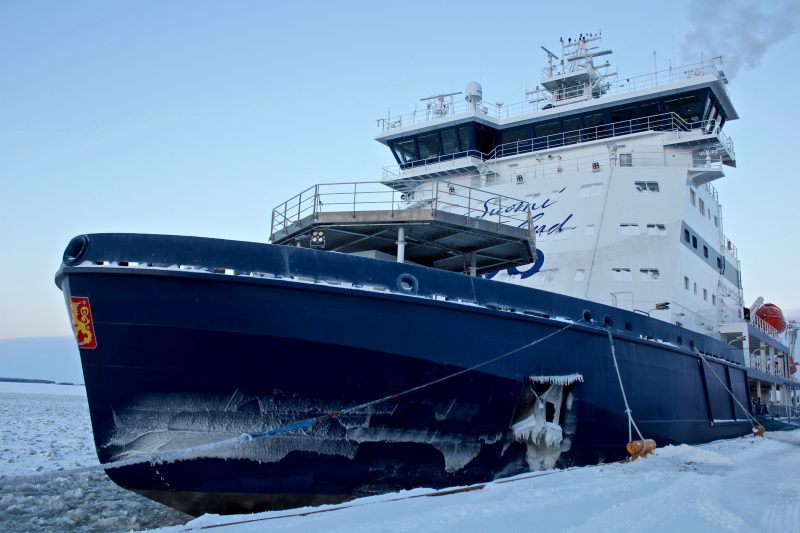Going greener: Finland’s new gas-fuelled icebreaker
Finland’s new icebreaker, Polaris, is the world’s first to run on liquefied natural gas (LNG) (Sam KINGSLEY)
ABOARD THE ICEBREAKER POLARIS (Finland) (AFP) – The steel behemoth pushes ahead, crunching the ice as it navigates the northernmost tip of the Baltic, considered one of the most polluted seas in the world. But unlike other icebreakers spewing diesel, this state-of-the-art ship boasts cleaner fuel.
In the freezing darkness of a February morning, the immense Polaris, which at 10,000 tonnes weighs more than the Eiffel Tower, ploughs effortlessly through the half-metre (20-inch) thick ice.
“I used to fly planes but I don’t miss it at all. In here it’s like driving a spaceship!” says second officer Valtteri Salokannel on the ship’s bridge, surrounded by satellite images of the ice and rows of coloured lights.
The bridge shakes gently but the thick windows cut out the noise of the howling winds on deck and metallic clanging of ice against the reinforced steel hull.
The 128 million-euro ($145-million) vessel is tasked with keeping shipping lanes open for up to six months of the year, allowing a constant stream of cargo ships carrying steel, paper products and chemicals in and out of the ports serving northern Finland and neighbouring Sweden.
The ship’s captain, Pasi Jarvelin, boasts that Polaris is the most eco-friendly icebreaker in the world.
“We don’t release anything into the sea, such as shower water, grey water — we take that back to land. And the propellers use biodegradable grease,” he tells AFP.
But most importantly, it is the world’s first icebreaker to run on liquefied natural gas (LNG), a lower-carbon alternative to the diesel fuel which powers most large ships.
“LNG is the cleanest known fuel that we can use,” Jarvelin said.
– Cleaner credentials –
Polaris’ eco-friendlier credentials will be of increasing importance during the ship’s 50-year lifespan, as the region’s pristine white ice hides waters that have been singled out by the European Commission and WWF, among other international bodies, as in urgent need of action to reduce high levels of pollution.
Very little outside water flows into or out of the Baltic Sea, almost completely enclosed by nine countries including Russia, Germany and most Nordic states.
This means chemicals from agriculture and other industry remain trapped in the water in increasingly strong concentrations, according to bodies such as the Baltic Marine Environment Protection Commission (HELCOM).
In addition, says the European Environment Agency, temperatures in the Baltic have risen over five times faster than the global average over the past 25 years.
– Significant first –
Until now, Polaris has been running on low-sulphur diesel oil, or filling up with natural gas brought in by lorry.
But this month, for the first time, the 110-metre ship filled up with gas from the newly built Manga LNG terminal, a storage facility perched at the end of a barren, snow-swept harbour in Tornio, northern Finland.
The Manga terminal opened 15 months ago to supply natural gas to a local steel plant and other nearby industry.
Refuelling the vessel, known as bunkering, took eight hours on its first run, as engineers busily monitored computer screens and sometimes adjusted the snow-covered valves, filling the ship’s two vast, 400-cubic-metre (14,000-cubic-feet) fuel tanks a little at a time to ensure the correct pressure and distribution.
“It was a significant day,” Jarvelin told AFP after the ship had set off to sea again.
“Now we’ll always have a supply of LNG up here in our home, Tornio.”
Although liquefied natural gas is a fossil fuel and therefore generally considered non-renewable, it is widely seen as more environmentally friendly than coal or oil because it burns more efficiently and emits less carbon.
Running on LNG is also expected to prove cheaper than diesel over the ship’s lifetime.
“Polaris is the only icebreaker in the world that runs on LNG,” maritime technology professor Pentti Kujala, of Aalto University, Finland, told AFP.
“The big variation of power you need for icebreaking can sometimes cause challenges for LNG engines, so it’s less common than diesel,” he said.
In exceptionally tough conditions, Polaris can switch its engines to diesel.
Built in 2016 by Arctech Helsinki Shipyard, it is also equipped with pumps, filters and inflatable booms in the event of an oil spill in icy conditions, which is considerably harder to clean up than in open water.
Much of the oil spill risk comes from the southern Baltic, known as the Gulf of Finland, having some of the heaviest marine traffic in Europe, with levels set to rise dramatically over the coming decades.
– Ice and snow-how –
Finland is the only nation in the world where all of its ports can — and regularly do — freeze in winter, meaning icebreakers are indispensable to keeping trade flowing.
The Nordic country’s expertise means Finnish companies have built two thirds of the world’s 150 major icebreakers.
Unlike most other icebreakers though, the Polaris has a sauna on board — this is a Finnish ship, after all — to help keep the around 16 crew members warm during their 20-day stretch at sea.
And with temperatures outdoors nearing minus 20 degrees C (minus four degrees F), the boat’s inside spaces are well insulated.
“Actually officers don’t need to go outside much,” admits Salokannel.
“But I do venture out there sometimes, just for fun, to sniff the air and see what’s going on.”
Disclaimer: This story is published from a syndicated feed. Siliconeer does not assume any liability for the above story. Validity of the above story is for 7 Days from original date of publishing. Content copyright AFP.


